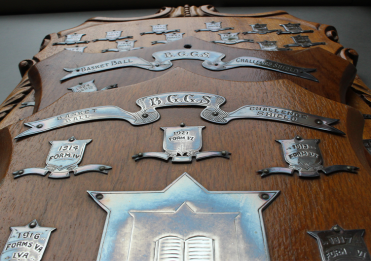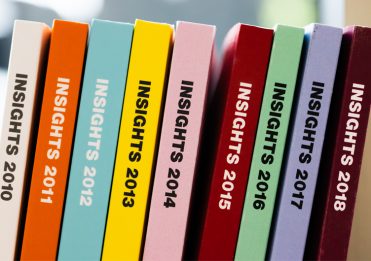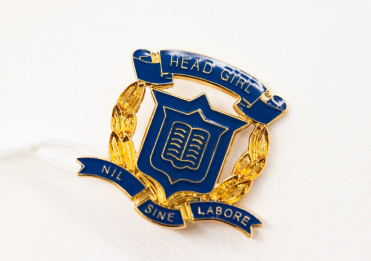There are some libraries we visit that inspire us with awe the moment we step through the doors—that ‘gasp’ of wonder, imagination, and quiet calm. The La Trobe Reading Room (opened in 1913) in the State Library of Victoria—a glorious octagonal domed room with a ceiling rising five floors above the parquetry space—is one such room. Another is the exquisite Map Room in the State Library of New South Wales, in the heritage rooms of the Mitchell Building (opened in 1910). The very walls of these spaces exude history, where the desks bear the scratchings and marks of library lovers past—passionate poets, stressed students, dedicated researchers—and the shelves, full of books with rustic and exquisite spines, beg to be explored. This effect is a result of the dedication of the library staff and their passionate patrons who have preserved the historic objects knowing the objects give these spaces character, story, and wonder.

2021 ‘The Map Room’, State Library of New South Wales
Girls Grammar’s Beanland Memorial Library, housed in the Elizabeth Jameson Research Learning Centre since 2015, has such an effect. There is nothing quite like watching a prospective families’ tour or new students entering the library. They look up and around with quiet admiration and often audible gasps. While the building may be modern and the technology current, the library’s 140-year history is preserved and celebrated in the historic furniture that is integrated throughout its five levels. In these furnishings the students see their past and connect it with their present.

2024, The maple bookcase in the library foyer of the Elizabeth Jamieson Research Learning Centre
The most prominent furnishing in the foyer of the Beanland Library is an historic maple bookcase, which holds the Kennedy Caincross collection of prize books donated by past students. This maple bookcase, standing over two meters in height with moulded cornices above two levels of glazed sliding doors and all enclosing adjustable shelves, was one of a series that adorned the walls of the School’s first library building in 1958, located in the Reference Library on the second floor, and contained the extensive non-fiction collection.

In front of the maple bookcase, left to right: Natalie Wu (8B); Allegra Fotheringham (8G); Chloe Liu (8E)
It was originally thought the maple bookcase was the one referred to in the 1933 School Magazine—’a fine bookcase was bequeathed to Girls Grammar in 1933 by Lieutenant Colonel Plant in memory of his daughter, Mrs Fin(d)lay. It was first housed in the ‘Main Hall’ of the Main Building and contained some of the Colonel’s own collection, as well as the library collection which had been rapidly expanding following Sophia Beanland’s bequest of £500 in 1925′ (Brisbane Girls Grammar School, 1933). However, more research is necessary to confirm which bookcase was bequeathed by Lieutenant Colonel Plant.
When that 1958 building was demolished to make way for a much larger library in 1975, the maple bookcase was not included in the furniture of the more modern library. It seems to have been put in storage and fell into disrepair. However, in the 1980s, two young resource teachers, Mrs Kristine Cooke (Harvey, 1967) and Ms Anne Farley, noticed the bookcase being loaded onto a truck outside the Western Wing.

1965, Brisbane Girls Grammar Reference Library, the purpose-built maple bookcases in the background
Concerned that the historic furniture was being discarded, Mrs Cooke stood in front of the truck and insisted on first discussing the planned removal with Mr John Pietzner (BGGS Business Manager, 1986-2005). After some discussion, Mr Pietzner agreed to have the bookcase returned to the Western verandah and organised a valuation of the piece. When he discovered the value of the bookcase, Mr Pietzner promptly changed his mind and had the old library bookcase restored and temporarily housed in the Deputy Principal’s office (Cooke, 2023). It was wonderful then to have the maple bookcase (valued at $8000 in 2003) take pride of place in the latest location of the Beanland Memorial Library in 2015 under the care of the Library Director, Mrs Cooke (Director of Library and Information Services 1996-2022), and it is fitting that it should hold the treasured book-prizes from Grammar girls past.

A room full of history—L203 of the Beanland Memorial Library
This bookcase is not the only historic piece in the library spaces. Other furniture that connects the current students to their School’s rich past are the tables and chairs on Level 2 of the library, in Room L2.03. A standout is the large, silky oak table with 12 chairs. This beautiful long table was purchased in 1930 and was originally the table used by the School Board of Trustees. Mrs Cooke, who always found a home for such older pieces, had the table placed in the Estelle Burke Reading Room of the 1975 library, and it was around this table where the School’s reading club, the Libellum Society, first met in 2001.

2012, Ms Rachael Christopherson and members of the Libellum Society in the Estelle Burke (1947) room
In 1962, glass tops were added to this and other wooden tables to protect the surfaces, and so that maps and diagrams could be displayed under the glass while the girls were studying (Williamson, 1962). Two of these glass-topped tables remain in the current library and the tradition of displaying artworks and items of interest under the glass continues. The chairs were initially an exciting addition to the first library, the purchase of ‘a dozen chairs for the Reference Library’ being noted in the Library Report of 1961 (Ernst, 1961). Before these chairs were placed around the long table in a space in the Elizabeth Jameson building, Mrs Cooke had the chairs restored with their original blue upholstery. Room L2.03 also features an unassuming, pine teachers’ desk, one of the many desks from the early classrooms, and thus another piece of our School’s history.
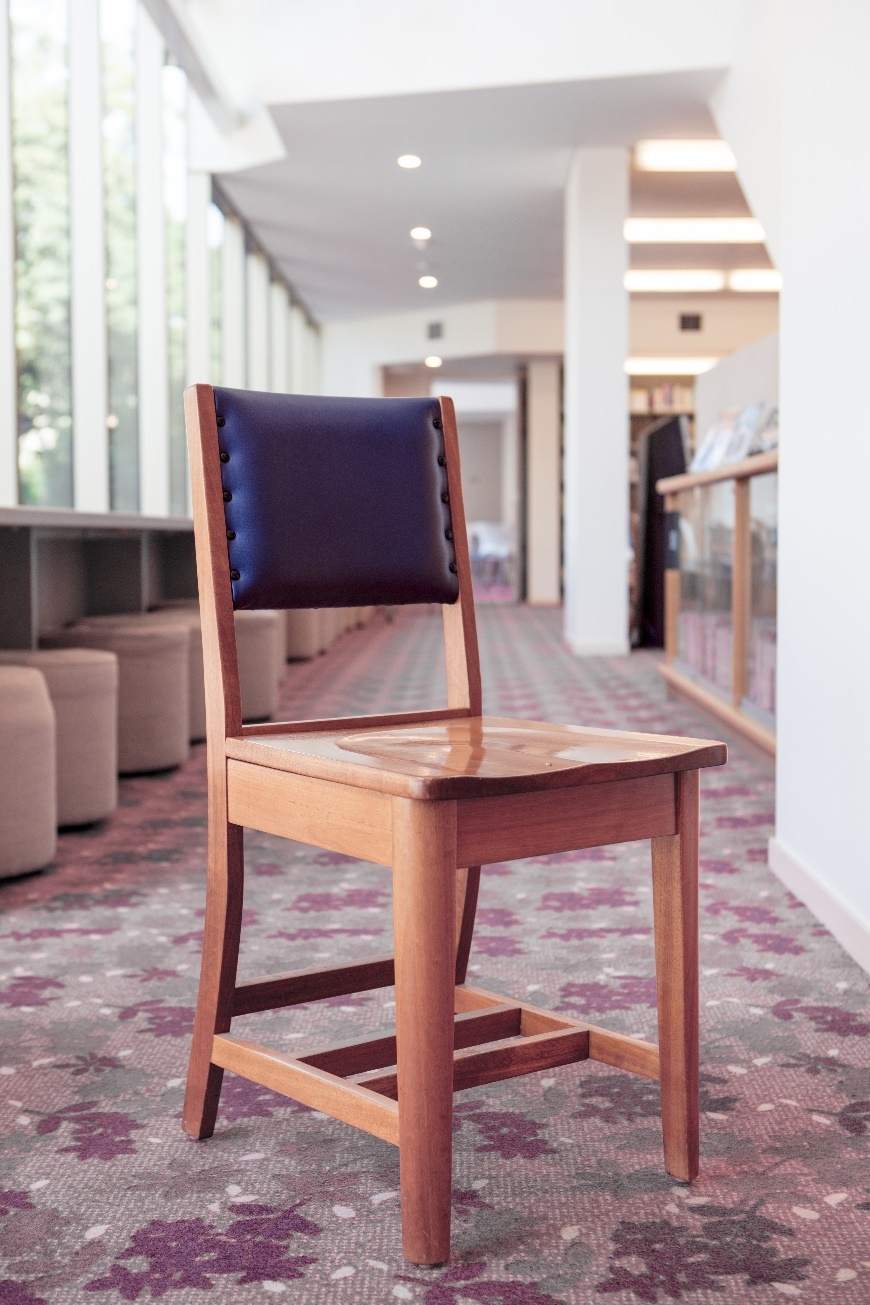
A 1961 library chair refurbished in 2015

The experience of wonder when history and aesthetics work harmoniously in a space
In addition, Levels 1, 2, and 4 of the library spaces in the Research Learning Centre feature magnificent long tables around which the girls often gather to study, collaborate on assignments, or enjoy a puzzle or board game. The atmosphere can be noisy or quiet, but always one of curiosity and learning. The long tables have always been purposed for the gathering of the girls.
In 1981 the Parents and Friends Association generously gifted $10 000 for the purchase of the silky oak tables for the Boarding House’s new dining room which was relocated to, what is now known as, the Annie Mackay Room. Mrs Judith Hancock (Principal, 1977-2001) reflected that ‘this furniture will be in the School for time immemorial and will turn the area into a very dignified meeting place’ (Hancock, 1981). True to her word, the tables have remained a well-loved and well-used installation around which friendship and minds are developed. After suitable restoration of the beautiful, solid silky oak tops, six of these tables are now popular places for studying and learning on Levels 1 and 4.

The 1980s’ Boarders’ Dining Room with silky oak tables and benches
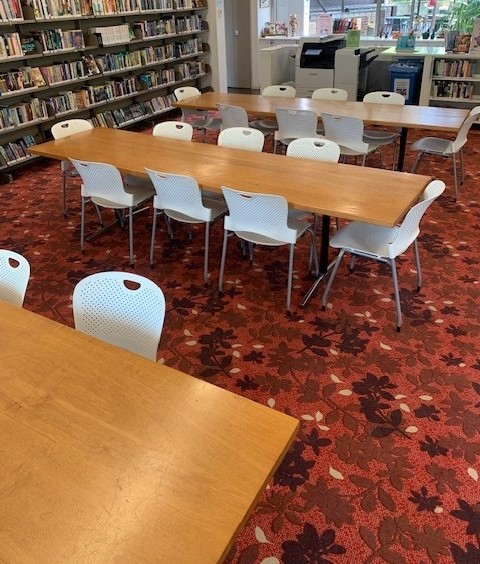
Three silky oak tables on Level 1 of the RLC
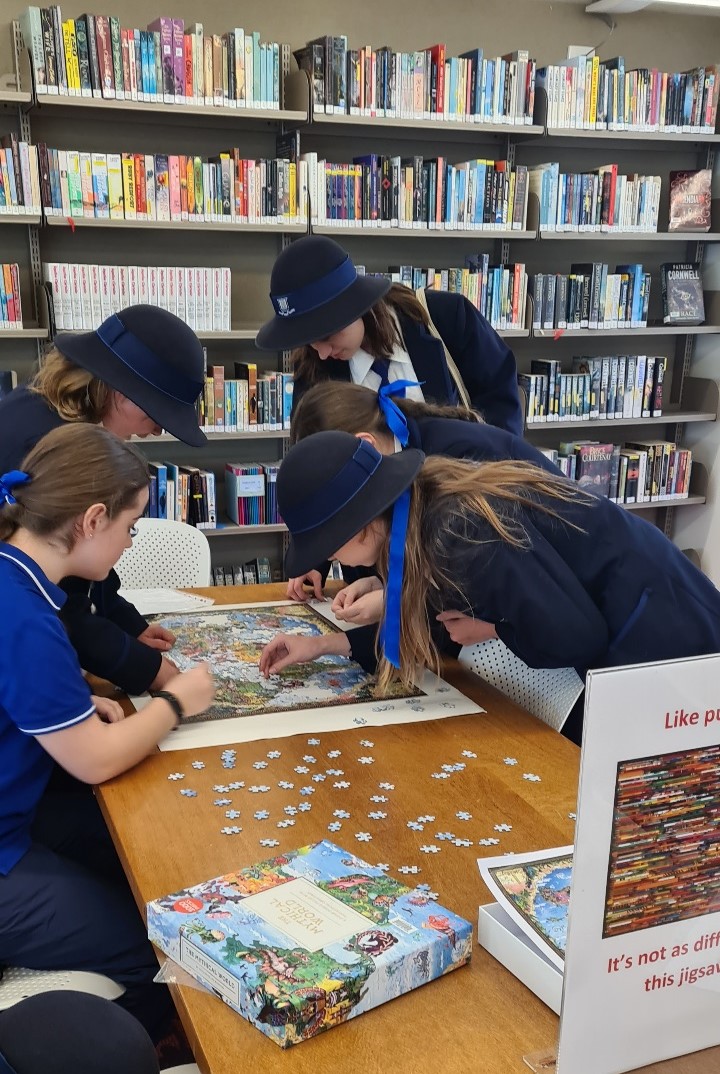
2023, Puzzling in the library
‘You save the furniture; you save the heritage,’ reflected Mrs Cooke whose committed care of, not just the library’s collection, but the School’s historic objects is evident in the diverse assortment of furnishings throughout the five floors of the Research Learning Centre. Art desks and chairs from the 1930s, a podium from the old Assembly Hall, desks from the 1920s and 1950s, and a myriad of shelves, tables, and antique sideboards from the rooms and corridors of the Main Building adorn the Beanland Library.
Each has a story, and each reminds us of past Grammar girls and forms a direct, physical connection to the students of today. They ‘add warmth to the library’ (Cooke, 2023), and set it apart from other school libraries that may throw out the old solely to embrace the new, but perhaps lose a vital part of themselves when they do. Our Girls Grammar history is valued, preserved, and lived in each of the library spaces, for as Mrs Cooke commented, ‘To throw (the furniture) away is like throwing away your family album’ (2023).
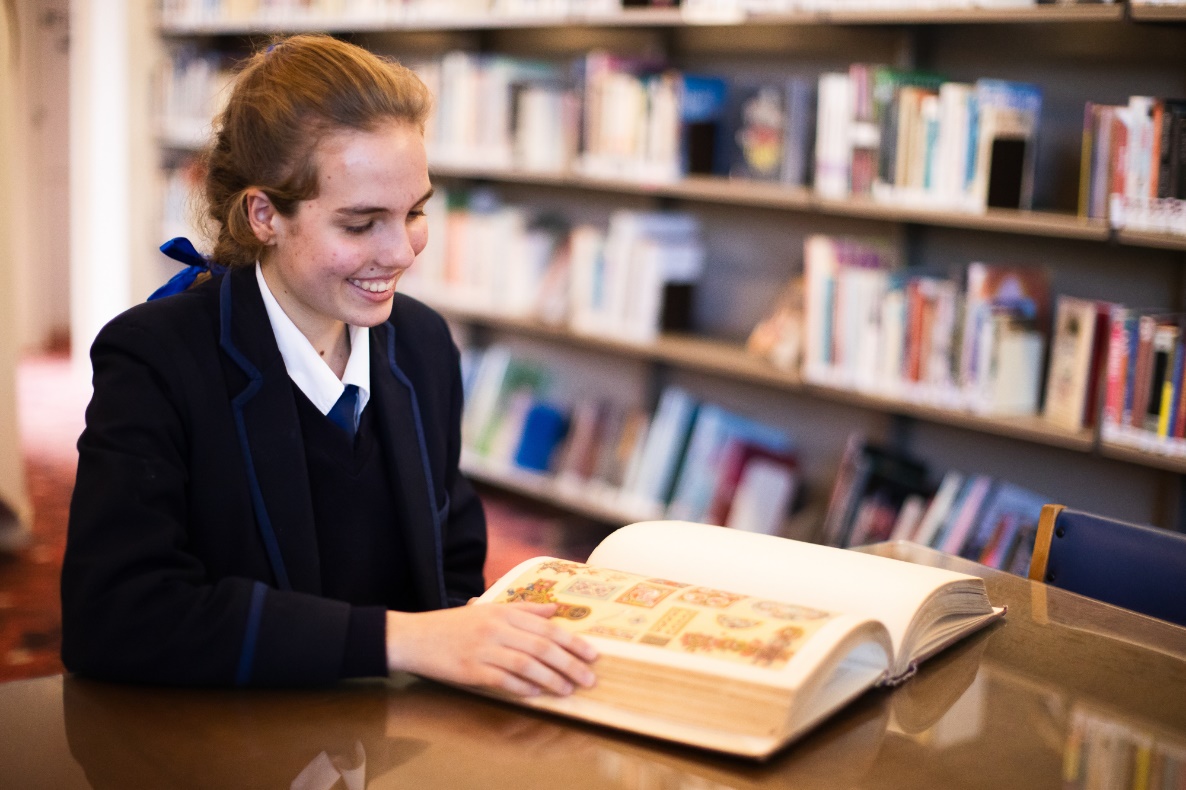
History in action; Charlotte Wilson (10G) seated on a 1962 chair at the 1930 table, reads a 1928 book in the Beanland Memorial Library, opened in 2015
Ms Rachael Christopherson
Director of Director of Library and Information Services
References
Brisbane Girls Grammar School. (1933, December). Library Notes. Brisbane Girls’Grammar School Magazine, p. 41.
Cooke, K. (2023, December). Memories of the Library. (R. Christopherson, Interviewer)
Ernst, M. (1961, December). Library Notes. Brisbane Girls’ Grammar School Magazine, p. 15.
Hancock, J. (1981). Brisbane Girls’ Grammar School Parents’ and Friends’ Association Newsletter: From the Principal. Brisbane: Brisbane Girls’ Grammar School.
Paterson, B. (1958, December). A Short History of the Brisbane Girls’ Grammar School Library. Brisbane Girls’ Grammar School Magazine, pp. 54 – 59.
Williamson, H. (1962, December). Library Notes. Brisbane Girls’ Grammar School Magazine, p. 16.

1965, Brisbane Girls Grammar Reference Library


